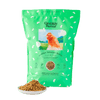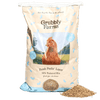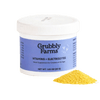We’ve all had it happen... that mystery nest of eggs, the full egg carton you forgot about, that random egg you found in the chicken coop enclosure. You may find yourself asking, is this egg safe to eat? How old are these eggs? And if you haven’t had one of those situations happen to you yet, you probably will in the future! Knowing how to check chicken eggs for freshness is helpful for determining if the eggs are safe to eat. There are several different freshness tests you can conduct on chicken eggs to determine how fresh they are. These tests can be both functional and fascinating!
The Float Test
The float test is one of the easiest ways to get a reliable estimate of the age of an egg. The float test is based off of the egg’s air cell size. Every egg has an air cell, which is a bubble of air between the shell and the inner shell membranes. The air cell is formed when the contents of the egg cool and shrink slightly after the egg has been laid. As the egg ages, the air cell grows larger as the contents of the egg evaporate. During a float test, the size of the air cell will determine the buoyancy of the egg.
Here’s how to conduct a simple float test on an egg:
- Fill a clean glass jar with room temperature water.
- Gently place the egg in the water.
- Watch to see if the egg sinks to the bottom, floats slightly, or floats completely.
A fresh egg will sink and lay sideways on the bottom of the jar. The air cell is so small in a freshly laid egg that the egg will not float at all. An egg that is about 1 week old will have the blunt end slightly raised but the pointy end will still be touching the bottom of the glass. The air cell is slightly bigger in a week-old egg which causes the blunt end of the egg to rise slightly. Eggs that are about 2-3 weeks old will float vertically near the bottom of the glass. The air cell is big enough that will cause the egg to be suspended in the water.
When an egg floats near the very top of the glass of water, you know that it is a pretty old egg! While a floating egg may not necessarily be bad, the quality of the egg has probably declined enough to make the egg undesirable for eating. How well an egg retains its quality depends on how the egg was stored and factors such as temperature and humidity.

Candling
Another way to determine the estimated age of an egg is by candling the egg. Candling eggs involves using a bright light to illuminate the inside contents of the egg. Candling is usually done when incubating eggs to see how the embryo is developing. However, candling can also be helpful for aging an egg.
Here’s a basic way to candle an egg:
- Get a bright, strong flashlight and find a dark location (a windowless room sometimes works well or a closet).
- Hold the egg up to the flashlight, angle the egg so that the light is shining near the blunt end of the egg but not directly at the air cell (which is at the blunt end of an egg).
- Examine the contents of the egg as well as the size of the air cell.
- Use an egg air cell size chart to get a better estimate of the age of the egg.
When candling an egg, you want the light to shine into the egg at the blunt end, but you don’t want the air cell to inhibit the light from illuminating the rest of the contents within the egg. Slightly rotating the egg will allow you a good view into the egg. Candling eggs that have light-colored shells are easier than eggs with dark-colored shells. When candling an egg, you will be able to see the egg air cell and the egg yolk. The egg yolk will look like a fuzzy, darker blob in the center of the egg.
To gauge the age of an egg by candling, you can look at the size of the air cell as well as examine the clarity of the yolk. If the egg’s yolk is easy to identify and has a somewhat distinct silhouette within the egg, then the egg is old. As an egg ages, the albumen (egg whites) thin out which makes the egg yolk easier to see when the egg is candled. You can also give the egg a gentle twist to make the contents swirl. An egg yolk that moves freely within the egg indicates that the egg is old since the albumen is thin enough to allow the yolk to move.
Also examine the egg’s air cell size. A fresh egg will have an air cell size that is no more than 1/8th of an inch. As an egg ages, the air cell will become larger as the contents within the egg evaporate. How fast an egg ages will depend on what humidity level and temperature the egg is stored at and the density of the eggshell. As long as an egg does not have a bad smell or is off-colored, it is still safe to eat.

The Bowl Test
The bowl test relies on your observation skills to get an estimate of the age of an egg. You can visibly see changes in the egg yolk and egg albumen (egg whites) of an aging egg. The bowl test will require you to crack an egg open, so aging an egg this way assumes you are going to either use the egg or throw it away after you have examined the contents.
To do a bowl test, follow these steps:
- Get a clean, shallow bowl.
- Crack the egg in question into the bowl.
- Examine the albumen and yolk of the egg.
Fresh eggs will have an albumen that is somewhat cloudy, thick and tall, and will easily support a full, round egg yolk. Older eggs will have an albumen that is clear, thin and flat, and will weakly support an egg yolk that is flat and fragile. Eggs that are older will have more of a tendency for the yolk to break when you crack the egg because moisture from the albumen of the egg has moved to the yolk membrane. The extra moisture stretches out the membrane making it weaker and easier to break. However, even eggs with flat a yolk and thin albumen are still safe to eat.
When it comes to examining the inside contents of an egg, there are a lot of other interesting things you might find! Of course, normal fresh eggs will look like your ordinary egg with a bright yellow yolk surrounded by the albumen. However, sometimes you may come across some interesting additions.
Two such additions that may cause some alarm are blood spots or meat spots. Blood spots in an egg are from when the egg was forming inside the hen and some blood accidentally got enclosed as well. While blood spots are safe to consume, they may not look that appetizing! Meat spots are similar to blood spots, except they occur when a piece of shed reproductive lining accidentally gets enclosed in the egg during the process of forming the eggshell. Meat spots are also safe to eat, however they too may not look too appetizing. Neither blood spots nor meat spots indicate anything about an egg’s freshness.
The Sensory Test
Lastly, you can also conduct a sensory test on an egg. This old-fashioned method of aging an egg relies on your sense of smell, what you see, and what you hear. Aging eggs may have several distinct factors that can tell you if the egg is fresh or old! To conduct a sensory test, pick up the egg in question and evaluate these things:
- Smell the Egg- if the egg has an off-smell, a sulfur smell, or a rotten odor, then it is old and bad!
- Observe the Eggshell- if you see stuff oozing from the shell, the egg is bad (don’t mistake condensation from a cold egg as bad stuff oozing from the shell)
- Shake the Egg- listen for jostling contents, older eggs will make more noise as the albumen is thinner and allows the contents to move more freely
While the sensory test may not be a reliable way for determining the exact freshness of an older egg, it can be helpful for quickly identifying a bad or rotten egg! Don’t eat eggs that smell bad, have stuff oozing from the shell, or are discolored when cracked open.
When in Doubt, Check it Out
These four tests should give you plenty of options for determining the freshness of chicken eggs! Whether you experiment with the float test, check out the inside contents of an egg through candling, break open the egg for examination, or simply rely on your senses, you should be able to get a rough estimate on how fresh an egg is through one of those four simple tests.











